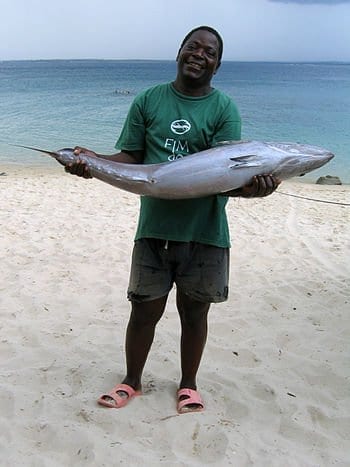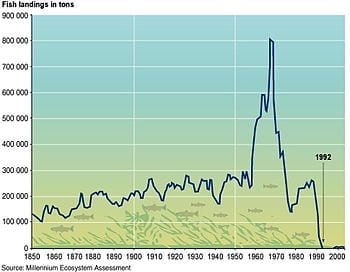
The results from a set of international studies may now revolutionise fishing regulations.
Many popular measures to combat overfishing help conserve mostly small juvenile fish. The results from a set of international studies may now revolutionise fishing regulations.
Before it lands on our plate, any wild fish should spawn at least once. This is a basic principle in fishery management. Accordingly, professional fishers and recreational anglers have to release any fish they catch that is smaller than the minimum size stipulated in many fisheries regulations; only the big ones they are allowed to retain. However, this policy does not take into account the extraordinary ecological importance of large spawners, as was pointed out in several recent studies led by Dr Robert Arlinghaus, Professor for Integrative Fisheries Management, of the Leibniz-Institute of Freshwater Ecology and Inland Fisheries (IGB) and the Humboldt-University of Berlin. The unintended consequences are lower harvest in terms of number of fish and smaller fish within the stock. Scientists from the Australia, Germany and the United States now propose that it might be better to implement harvest slots as an alternative to the popular minimum size regulation in recreational fisheries. These ‘harvest windows’ would protect both the young offspring and the experienced heavyweights, and at the same time conserve the big fish that are rather popular with hobby anglers.
“I’m glad that I’m not fat (…) I’m glad that I’m such a thin herring, because to be thin means to be free“. These controversial lyrics from a song by the German singer Marius Müller-Westernhagen describe – albeit unintentionally – the dilemma of many existing fishing regulations. Because up to this point, many measures taken against overfishing aim at protecting the small fish, the ones that reach sexual maturity for the first time. Initially, the underlying idea sounds plausible: juveniles are to be conserved until they are big enough to proliferate at least once. After the reproduction process is completed, they can easily fall victim to a fishhook or end up in a fishing-net. But this only works as long as the existing fish stock keeps producing enough offspring.
Old fisheries biological models were not encompassing of reproduction
The traditional fisheries biological models from the 1940s and 1950s claimed that the fishing yield was to be best when the existing fish stock consists mainly of small and young fish that grow quickly. “While this is still the case, the calculations of that time did not take into account the reproduction ability of fishes of different sizes and ages. Many of the traditional mathematic models only considered the growth and mortality rate of fish stocks, while the reproduction factor was considered unlimited or unpredictable,” explains Professor Robert Arlinghaus, the senior author of the set of new studies, from the IGB in Berlin. “They simply could not fathom that the effects of fishing would decimate the spawning stock so strongly that there would be an offspring shortage.”
Big fish have an extraordinary ecological and economic function
One thing holds true for many fish species: When the quantity of parental fish is low due to overfishing or environmental impacts on habitats, a greater quantity of eggs usually leads to a higher number of juvenile fish. In this regard, the productive large female fish play a fundamental role in repopulation. If the mega spawners are systematically taken out, this favours more inexperienced, smaller females whose reproductive output is lower. But there are also reasons in our economy and our society that speak in favour of protecting the “Big Old Fat Females”. “Anglers love photos with big fish in remembrance of the special catch, and professional fishers get higher market prices for some fish species, such as cod, if the fish is bigger,” says fisheries scientist Arlinghaus. Unfortunately, big fish are extremely rare in harvested fish stocks.
Big is sexy
Even fin-wearing underwater residents prefer large lovers in their world. That is hardly surprising. Several recent studies, including work in the laboratory of Prof. Arlinghaus, have shown that larger fish not only produce disproportionately more eggs, but also larger eggs, which in turn results in offspring that is more resistant. In contrast to many mammals and to us humans, fish grow all their life and invest in reproduction well into old age. “From an ecological point of view it is better if a fish population consists of different size and age classes. This diversity in age pays off. Oftentimes, fish of various sizes and ages reproduce at different times,” explains Arlinghaus. “If events in the environment destroy the eggs of a specific timeframe, the population can still guarantee the offspring and thus contribute to more stable stocks.” Also, the big and the small onesmay take with you any fish that fits within the slot,” explains Arlinghaus. Anything smaller or bigger than the harvest window must be returned to the water and is allowed to stay alive. “We have shown in computer simulations that the use of the harvest slots m, the old and the young ones, they all have different places to stay, different routes to migrate, and different nutritional plans. If you strongly exploit the population by catching and removing a vast amount of fish, consequently creating a fish stock that mainly consists of juvenile and first maturing fish, this will negatively affect not only the reproductive performance of the stock, but also the entire food web and ecosystem.
The Latest on: Overfishing
[google_news title=”” keyword=”Overfishing” num_posts=”10″ blurb_length=”0″ show_thumb=”left”]
via Google News
The Latest on: Overfishing
- Trapped in net of apathy, Kolis fish for a better dealon May 8, 2024 at 4:04 pm
Considered one of the original inhabitants of the city, Kolis are finding it hard to eke out a living due to overfishing, use of purse seine nets, pollution, steep rise in fuel prices and govt apathy.
- Species on fish overfishing list in US at all-time low in 2023on May 8, 2024 at 10:16 am
In a sign of a recovery in US fisheries National Oceanic and Atmospheric Administration officials said that in 2023 the number of fish on the US government overfishing hit an all-time low ...
- Mackerel and snapper recover as US overfishing list reaches an all-time lowon May 7, 2024 at 10:00 am
The number of fish on the US government's overfishing list sunk to a new low last year in a sign of healthy fisheries, federal officials said. The National Oceanic and Atmospheric Administration (NOAA ...
- Number of fish on U.S. overfishing list reaches an all-time lowon May 6, 2024 at 5:49 pm
The number of fish on the government’s overfishing list sunk to a new low last year in a sign of healthy U.S. fisheries, federal officials said.
- Social Security, Medicare go-broke dates pushed back; overfishing fears recedeon May 6, 2024 at 1:44 pm
WASHINGTON — The go-broke dates for Medicare and Social Security have been pushed back as an improving economy has contributed to changed projected depletion dates, according to the annual Social ...
- The number of fish on US overfishing list reaches an all-time low. Mackerel and snapper recoveron May 6, 2024 at 10:46 am
Federal officials say the number of fish on the government’s overfishing list sunk to a new low last year in a sign of healthy U.S. fisheries.
- Hake Fisheries’ Remarkable Recovery Is a Sign of Hope for Our Oceanson May 6, 2024 at 8:00 am
Mild, flakey, and delicious—perfect for a fry-up—hake is a huge part of Galicia's economy and gastronomy, and there are more than ever.
- The number of overfished U.S. species reaches an all-time lowon May 5, 2024 at 5:00 pm
It looks like you do not have any active subscriptions. To get one, go to the subscriptions page. The number of fish on the government’s overfishing list sunk to a new low last year in a sign of ...
- NOAA Fisheries’ overfishing list shrinks to record lowon May 4, 2024 at 9:09 am
NOAA Fisheries reported that a record-low number of fish stocks are currently being overfished in its latest Status of the Stocks report.
- Fish are shrinking around the world. Here’s why scientists are worried.on May 4, 2024 at 4:00 am
Fish are shrinking around the world. Here’s why scientists are worried. Figuring out the reason why has big implications, with billions of people depending on seafood for protein. There’s something ...
via Bing News










